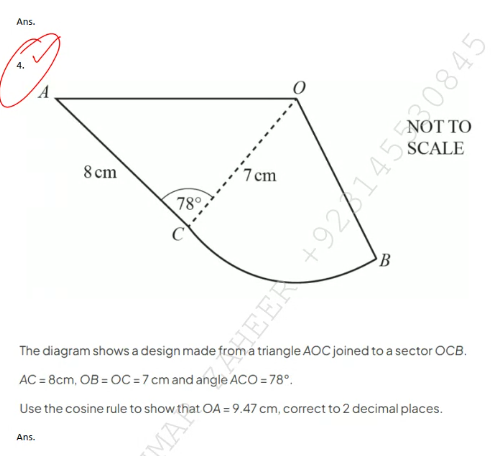Use the cosine rule to show that OA = 9.47 cm, correct to 2 decimal places.

Understand the Problem
The question is asking to use the cosine rule to calculate the length of OA in triangle AOC, given the lengths of the sides AC, OC, and the angle ACO.
Answer
The length of $OA$ is approximately $9.47$ cm.
Answer for screen readers
The length of OA is approximately $9.47$ cm.
Steps to Solve
- Identify the given values We have the following measurements:
- $AC = 8$ cm
- $OC = 7$ cm
- The angle $ACO = 78^\circ$
- Apply the cosine rule The cosine rule states that for a triangle with sides $a$, $b$, and $c$, and respective opposite angles $A$, $B$, and $C$: $$ c^2 = a^2 + b^2 - 2ab \cos(C) $$
For triangle AOC, we need to find $OA$. Let's set:
- $AC = b = 8 \text{ cm}$
- $OC = a = 7 \text{ cm}$
- Angle $ACO = C = 78^\circ$
- Side $OA = c$ (what we want to find)
-
Plug the values into the cosine rule formula
Using the values from the previous step:
$$ OA^2 = AC^2 + OC^2 - 2 \cdot AC \cdot OC \cdot \cos(78^\circ) $$
Replacing with the known values: $$ OA^2 = 8^2 + 7^2 - 2 \cdot 8 \cdot 7 \cdot \cos(78^\circ) $$
-
Calculate the squares and the cosine First, calculate $8^2$ and $7^2$: $$ 8^2 = 64 $$ $$ 7^2 = 49 $$ Now, calculate: $$ OA^2 = 64 + 49 - 2 \cdot 8 \cdot 7 \cdot \cos(78^\circ) $$
-
Use the calculator to find $\cos(78^\circ)$ and finalize the calculation From a calculator: $$ \cos(78^\circ) \approx 0.2079 $$
Now substitute this into the equation: $$ OA^2 = 64 + 49 - 2 \cdot 8 \cdot 7 \cdot 0.2079 $$
Calculating further: $$ OA^2 = 113 - 2 \cdot 8 \cdot 7 \cdot 0.2079 $$ $$ OA^2 = 113 - 23.3888 $$
- Now, solve for OA Finally, calculate: $$ OA^2 \approx 89.6112 $$ $$ OA \approx \sqrt{89.6112} \approx 9.47 \text{ cm} $$
The length of OA is approximately $9.47$ cm.
More Information
The cosine rule is particularly useful for any triangle where you know two sides and the included angle, allowing the calculation of the third side. In real-life applications, it helps in various fields such as engineering, architecture, and navigation.
Tips
- Forgetting to use the correct angle in radians vs. degrees.
- Incorrectly applying the cosine formula by confusing the sides and angles.
- Not squaring the sides or not taking the square root properly.
AI-generated content may contain errors. Please verify critical information